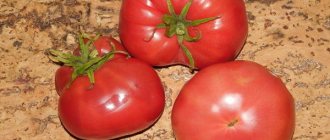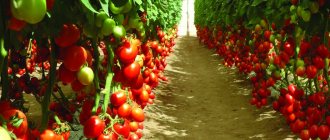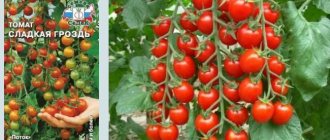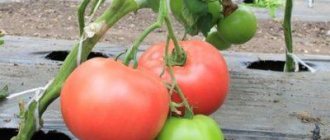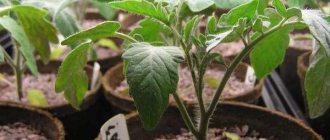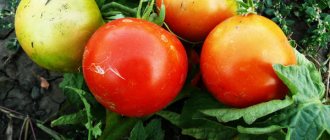Honey drop are delicious tomatoes that are used for pickling and making salads. The fruits are yellow, pear-shaped. The variety is known for its small aggressive stepsons and grows very quickly. Its yield is average, but this does not frighten vegetable growers - after all, the vegetable has a very unusual taste and a bright, rich aroma. Plants are grown in greenhouses and open ground; several bushes are usually planted in one garden or greenhouse. They normally tolerate the climatic conditions of central Russia, Belarus and Ukraine. Honey drop is highly resistant to the main diseases of nightshade plants.
Characteristics and description of the variety
Honey Drop is a mid-early variety whose ripening takes 110-115 days. The yield of the bush is from 2 kg, but much depends on compliance with the growing conditions. The height of one plant is up to 1.5 m when grown in open ground and up to 2.5 in greenhouses. Russian selection - the producer of the variety is . Read about the orange variety of tomatoes here.
Honey drop - delicious tomatoes that are used for pickling and making salads
The honey drop variety is not suitable for canning in marinade, since it has a thin skin and soft, watery pulp. You can pickle and ferment it.
Honey drop tomatoes are grown in small and medium-sized farms and commercial sites. The bush requires shaping, gartering and careful pinching throughout the summer season, otherwise it will grow greatly. Other characteristics of the variety:
- The fruits contain three chambers. They are medium in size, collected in long fan-shaped brushes of 8-15 pieces, rarely more. The shape of the fruit is drop-shaped, the color is bright yellow or honey. Tomatoes do not color at the same time as they ripen.
- Inflorescences are intermediate or simple. The seeds are small, soft, easily separated from the pulp and remain viable for a long time - up to 2-3, or even 5-7 years.
- The taste is sweet, rich, the aroma is bright.
- High resistance to blackleg and late blight.
- Excellent keeping quality.
Tomatoes grow in fan-shaped clusters with 8-15 fruits per cluster.
If you have picked unripe fruits, place them in a warm place to ripen.
Features of the variety
Honey Drop tomatoes have a unique taste - it’s not for nothing that they are classified as dessert fruits. The pulp is sugary and literally melts in the mouth, the yield is quite high (the best among yellow fruits), disease resistance, like most hybrids, is good. But the variety also has certain disadvantages - it is impossible to pickle the fruits due to the thin skin, and overripe tomatoes can crack (which they often do). This material will tell you about Dutch varieties of tomatoes.
Tomatoes of the “Honey Drop” variety have high yields
To prevent Honey Drop tomatoes from cracking, apply fertilizer with potassium monophosphate. In greenhouses, monitor humidity.
As for the demands on agricultural technology, this is a misconception - the bushes bear fruit well and grow quickly. True, garters and fertilizing will have to be done, otherwise there will be no return. It is convenient to grow the variety for commercial purposes, since it is not particularly “tender” and, again, does not require significant investments in agricultural technology. Honey drop is a hardened crop, ideally adapted to the climatic conditions of central Russia, Ukraine, and Belarus. Find out about Minusinsk tomatoes here.
Advantages and disadvantages
Among the advantages of the variety, we can highlight the fact that it:
- sprouts well;
- resistant to disease development;
- gives a lot of harvest;
- has excellent taste characteristics;
- contains a large amount of carotene and sugar.
The only disadvantages include the following:
- the bush is tall, which creates some inconvenience, and the vegetable crop needs constant staking;
- The plant must be frequently fed and watered, and the soil must be loosened.
All of the above disadvantages are more than compensated by the high yield, thanks to which the variety is especially loved by gardeners.
Growing
Seeds for seedlings need to be planted in the month of March - the choice of ten days depends on the region, the main thing is that the frosts are over. The optimal air temperature for growing is 22-25 degrees, planting depth is up to 2 cm. After 7-10 days, the seeds usually germinate, the seedlings begin to be actively watered, illuminated and fed. Picking seedlings is carried out in the phase of two true leaves. It is not necessary to do this (at your discretion). Read also about the De Barao tomato variety.
The honey drop variety grows best in sparse plantings, as it has a powerful spreading habit. The minimum distance between bushes is 45-50 in open ground and 50-60 in a greenhouse. Formation is carried out in one stem or two (in greenhouses they are usually formed in two). It is highly advisable to do pinching; to speed up coloring, it is recommended to thin out the leaves of the lower and middle tiers. At the end of the growing season, small ovaries are removed.
Tomato seeds "Honey Drop"
Despite their relative unpretentiousness, Honey Drop tomatoes require a large amount of fertilizing, especially during the formation of ovaries and the appearance of the first fruits. Focus on potassium, nitrogen and ready-made complex formulations such as Master, Plantophore.
Features of greenhouse cultivation
The seedlings are transferred to the greenhouse in early April. Be sure to heat the greenhouse so that the air temperature in it does not drop below 20 degrees and the tomatoes do not die. Seedlings need to be planted every 65 cm. Ventilate the greenhouse regularly - if this is not done, the humidity in it will increase and the likelihood of developing fungal diseases will increase. At the beginning of spring, when daylight is still short, create additional lighting. It is enough to water the greenhouse once a week, after which you loosen the soil. Find out about the characteristics of the Benito tomato variety at this link.
When growing “Honey Drop” in a greenhouse, it must be heated and regularly ventilated.
Honeydrop tomatoes in open ground
Experienced gardeners recommend growing tomatoes of this variety, like Mushroom Basket, Beef and Red Arrow, in open ground, since in greenhouses they get sick more often (due to humidity, planting density) and bear fruit worse. Seedlings are planted in open beds at the end of May. It is recommended to choose a bed in an open, well-lit area. Plant the seedlings at intervals of about 60 cm and be sure to tie them up. You need to remove shoots (we are talking about the formation of bushes) once a week, otherwise they will interfere with the formation of ovaries. Water moderately, but do not overwater the plantings. Use warm, settled water. As in the case of greenhouses, the soil needs to be loosened after watering.
Tomato "Honey Drop" is planted in an open, well-lit area
How to grow seedlings
To get a good harvest, you need to carefully consider the choice of seed and soil preparation.
Seed preparation
Before you go to the store to buy seeds, carefully study the information from the manufacturers. It wouldn’t hurt to ask your gardener friends which suppliers they prefer . Seeds must be disinfected before planting. Solutions of “Bud”, “Zircon” or any other growth stimulant will come to the rescue. You can also use proven folk remedies, for example, aloe juice.
Next, the material must be germinated. To do this you will need a cotton pad and a small plate. Unfold the disk and place the seeds on it. Cover the top with damp gauze and place it on a plate. Make sure that the seeds do not dry out. Experienced gardeners also advise adding aloe juice to the water.
Container and soil
It’s easy to prepare the soil yourself. To do this you will need garden soil, humus, peat and ash. When the mixture is ready, it should be disinfected. A solution of potassium permanganate is suitable for this.
If you buy ready-made soil, you should also make some efforts to enrich the soil with useful elements. The fact is that the main substance in purchased land is peat. It does not allow water to pass through well and is highly acidic, so such soil is sometimes not suitable for growing seedlings. To eliminate the problem, it is recommended to add dolomite flour or chalk to the soil. This will reduce the acidity level and make the soil more suitable for growing seedlings.
Important ! Any container is suitable for sowing seeds. For example, wooden boxes, flower pots, buckets. The main thing before planting is to wash the container well and dry it.
Sowing
When the container, soil and seeds are ready, start sowing. Make holes at a distance of 3 cm from each other, place seeds in them and sprinkle soil on top. Water the seedlings generously with warm water, place in a warm, bright place and cover with thin glass or film. This will create a favorable microclimate for germination.
Growing and care
First of all, pay attention to the air temperature.
The optimal temperature is about 23 degrees. As soon as the first shoots appear, place the container in a cooler place. Gradually open the film slightly. It is recommended to remove it completely after 2 weeks from the moment of planting.
Pay special attention to watering. For the most correct watering, it is recommended to use a pipette or syringe. Make sure that the water gets to the base of the sprout and not to the leaves. Under no circumstances should you water the seedlings with cold tap water. Otherwise, the bushes will become infected with root rot.
Remember that Honeydrop loves a lot of light. If there is a lack of sun, it is recommended to create additional lighting for the bushes using phytolamps.
After 10-15 days from the moment of planting, the first feeding should be organized. An excellent option for this is potassium superphosphate or ammonium nitrate. Apply the last fertilizing 10 days before planting the seedlings in the ground.
Productivity
The honey drop begins to ripen 100 days after planting. This variety of tomatoes is used for pickling (but not pickling), preparing salads, drying, and eating when ripe. Honey drop is an ideal tomato for allergy sufferers (they often have undesirable reactions to red fruits) and people with high acidity of gastric juice.
The yield of the variety is high, like the Carpal tomatoes, and the taste is good if the growing conditions are met. One bush produces an average of up to 2 kg of fruit. To increase productivity, fertilize and water the plants in a timely manner. You can pick tomatoes before they are fully ripe.
Tomato variety “Honey Drop” ripens 100 days after planting
Since Honey Drop tomatoes are sweet and tasty, they can be used to make “vegetable jam.”
Harvesting Honeydrop
Honey Drop is a mid-early variety, that is, its fruits can be harvested after 3-3.5 months - simultaneously with the harvest of the first red tomatoes. Fruiting lasts a long time - from mid-summer to the end of September.
After ripening and harvesting, tomatoes can be eaten fresh or canned. Due to its sweet taste, the fruits can be used to make jam. Less commonly, the fruits are used to make sauces and juice. They are often included in diet and children's menus; the product does not cause allergies.
The one who planted the Honey Drop variety notes that fruiting of tomatoes lasts a long time. You can harvest from mid-year until the last days of September. The harvested crop should be stored in a dark, dry place.
It is recommended to plant tomatoes in greenhouses, since in the middle zone and to the north it does not have time to ripen in open ground. But in southern climates you can plant it outdoors. Bushes must be tied to supports.
The originator recommends pinching the plant and growing it into 2-3 stems, but gardeners who grew it note that the yield will be higher if the extra stepsons are not cut off.
The fruits are perfectly stored, do not lose their taste and aroma, and can be transported over long distances.
Pests and diseases
Honey Drop tomatoes are highly resistant to the main nightshade diseases - gray rot, blackleg, and late blight. But proximity to other tomato varieties can be detrimental to them and result in infection of the bushes - this especially often happens in greenhouses and/or in close plantings.
The soil must be disinfected with potassium permanganate
In open ground, tomatoes get sick less often than in a greenhouse.
Before planting seedlings, be sure to treat the soil for preventive purposes, mulch them with straw or peat, and spray with non-toxic preparations against fungi and viruses. Do not flood the plantings and promptly adjust the air humidity in the greenhouse - the higher it is, the greater the chance that the plants will begin to get sick. Bushes will be protected from pests by mulching, spraying with celandine or peroxide, and ventilation. It is most effective to use a soap and water solution against aphids.
